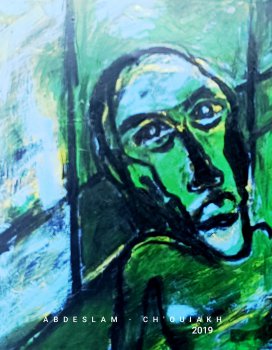



-
من نفس الكاتب - Du même auteur ▾
- Mon parcours artistique
- رحلة فنية من الخط العربي إلى التعبير الفني
- لحظة حاسمة: بداية جديدة
-
Ecrits Critiques Artistiques
- معاناة الجسد وأوهام الأمل: الوجه المشوَّه في زمن سجني
- حضور الغياب
- مرآة، ذاكرة الزمن تحت برج إيفل
- حكيم غيلان: منقِّب في الذاكرة البصرية لأصيلة ( نقد فني )
- مرايا ذاكرة الزمن: شهادة فنية في إشبيلية ( نقد فني ) الشويخ عبدالسلام، فرنسا
- الإبداع: حاجة وجودية أم سباق نحو التكريم؟ الشويخ عبدالسلام
- التجريد الطبيعي في التصوير الفوتوغرافي: تجربة عبدالسلام الشويخ ( نقد فني ) الشويخ عبدالسلام، فرنسا
- الظهور غير المرئي للوجود: قراءة فلسفية لعمل الفنان عبد السلام الشويخ ( نقد فني ) الشويخ عبدالسلام، فرنسا
- البحر كشاهد على المأساة الإنسانية: تركيب فني لعبد السلام الشويخ
- تحول معماري: الرؤية التشكيلية لعبد السلام الشويخ جدلية العمارة و
- الفن والإبداع: مرآة الإنسان في مواجهة التحديات المستقبلية

zaïla.AbdesArt
الشويخ عبدالسلام
ZAILA.COM
Asilah.fr
- HISTOIRE D'ASILAH ▾
- MOUSSEM CULTUREL D'ASILAH ▾
-
CULTURE LOCALE ▾
-
ARTISTES PLASTICIENS LOCAUX
- NARJISSE EL JOUBARI
- MOHSSINE HARRAKI
- AHMED SAID BAKKALI
- ANAS BOUANANI
- NAÏMA BOUOUNAT
- MOHAMED EJJEBARI
- MOHAMED EL BOUCHTI
- MOHAMED EL ALLAOUI
- BADR MESBAHI
- NAJAT KARKRI
- AHMED CHAMES EDDINE BAALICH
- MOHAMED AMINE MELEHI
- KARIM KARKRI
- SAAD JEBARI
- MOHAMED EL MESNANI
- TARIK FAITAH
- NORDIN BENSALAH BENSLEMAN
- MOHAMED ANZAOUI
- MOHAMED MILIHI
- ABDESLAM CH'OUIAKH
- JEUNES ARTISTES LOCAUX
- MUSIQUES
- POETES
-
ARTISTES PLASTICIENS LOCAUX
- ECRIVAINS ▾
-
ABDESLAM CH'OUIAKH ▾
-
ABDESLAM CH'OUIAKH
- نقد فني - ِCritique Artistique
- مرايا الذّاكرة ...مرايا الزّمن
- Entre l'Orient et l'Occident
- Le cercle … soleil d'Asilah
- Biographie en français
- Biographie en arabe
- Miroirs mémoire du temps HISTOIRE
- Miroirs mémoire du temps _ Anniversaires
- Miroirs mémoire du temps ( Clermont de l'Oise - France )
- Miroirs mémoire du temps ( Nümbrecht - Allemagne )
- Miroirs mémoire du temps ( Larache - Maroc )
- Miroirs mémoire du temps ( Séville - Espagne )
- l'autre moi
- الجسد الأنا ... الآخر
-
ABDESLAM CH'OUIAKH
- MANIFESTATIONS ▾
CULTURE LOCALE
MENU

معاناة الجسد وأوهام الأمل: الوجه المشوَّه في زمن سجني
الشويخ عبدالسلام، نقد فني
في عمله المؤثِّر، يواجهنا عبد السلام الشويخ بصورة مذهلة: وجه مشوَّه، بنظرة عميقة موجهة إلينا وكأنها نداء استغاثة صامت. هذا الشخص، الذي يبدو شبه هزيل، يحمل رأسًا غير متناسب — عريضًا من الأعلى، دقيقًا ومدببًا من الأسفل — وكأنه مغروس بين كتفين منكسرين، محملًا بعبء معاناة خفية.
تخترق المشهد خطوط عمودية ومائلة، تشكل خلفية تشبه قضبان سجن، تبني فضاءً زمنيًا مغلقًا، هندسيًا وسجنيًا، يحبس الجسد، وفي الوقت ذاته يفتح بشكل متناقض على آفاق وهمية. هذا التناقض يذكرنا بكتابات ميشيل فوكو حول «الجسد الطيع» وكيف يمكن للمعمار أن يُخضع ويضبط، لكنه في ذات الوقت ينتج سراب الهروب.
في هذا العالم، يظهر الأمل كخداع: أوهام لسعادة قريبة، تكاد تكون ملموسة، لكنها معلقة في زمن لا يوجد إلا في متاهات خيال بعيد. وهذا يقارب تأملات غاستون باشلار حول «الفضاء المتخيَّل»، حيث تُسقط النفس البشرية رغباتها هروبًا من واقع خانق.
يعزز الشويخ هذه الأجواء من خلال استخدامه لوحة ألوان باردة — الأخضر، الأصفر، الأزرق الفاتح — تمنح الضوء دورًا ملتبسًا. فهو يبدو كأنه يكشف ويخفي في آن واحد، فاتحًا امتدادًا لنظرة هذا الشخص نحو الخارج، ليقود المتلقي إلى التساؤل عن مصير هذا الإنسان الذي يبدو أنه يفقد الأمل بلا رجعة.
وهكذا، يقرأ هذا العمل كاستكشاف لمعاناة الجسد المحاصر في فضاء وزمن ضيقين، لكنه مفتوح بشكل متناقض على أوهام هشة، في مسرح لا يمكن للأمل أن يوجد فيه إلا في مظهر خادع.

Souffrance du corps et illusions de l’espoir : le visage déformé au temps de ma prison
Abdeslam Ch’ouiakh, critique artistique
Dans cette œuvre poignante, Abdeslam Ch’ouiakh nous confronte à une image saisissante : un visage déformé, au regard profond dirigé vers nous tel un appel silencieux à l’aide. Ce personnage, presque frêle, porte une tête disproportionnée — large en haut, fine et pointue en bas — semblant plantée entre des épaules brisées, chargées d’un fardeau invisible.
Le décor est traversé de lignes verticales et obliques, formant un arrière-plan semblable à des barreaux, qui bâtissent un espace clos, géométrique et carcéral, enfermant le corps tout en ouvrant paradoxalement sur des horizons illusoires. Cette contradiction rappelle les écrits de Michel Foucault sur le « corps docile » et la manière dont l’architecture peut soumettre et discipliner, tout en produisant le mirage d’une échappatoire.
Dans cet univers, l’espoir apparaît comme une tromperie : des illusions de bonheur proche, presque palpables, mais suspendues dans un temps qui n’existe que dans les labyrinthes d’une imagination lointaine. Cela rejoint les réflexions de Gaston Bachelard sur « l’espace imaginé », où l’âme projette ses désirs pour fuir une réalité étouffante.
Ch’ouiakh renforce cette atmosphère par une palette froide — vert, jaune, bleu clair — qui confère à la lumière un rôle ambigu, à la fois révélateur et dissimulant, ouvrant l’extension du regard de ce personnage vers l’extérieur, et poussant le spectateur à s’interroger sur le sort de cet être qui semble perdre irrémédiablement tout espoir.
Ainsi, l’œuvre se lit comme une exploration de la souffrance du corps enfermé dans un espace-temps étroit, mais paradoxalement ouvert sur de fragiles illusions, dans un théâtre où l’espoir ne peut exister que sous une forme trompeuse.
El sufrimiento del cuerpo y las ilusiones de la esperanza: el rostro deformado en tiempos de mi prisión
Abdeslam Ch’ouiakh, crítica artística
En esta obra conmovedora, Abdeslam Ch’ouiakh nos enfrenta a una imagen impactante: un rostro deformado, con una mirada profunda dirigida hacia nosotros, como un silencioso grito de auxilio. Este personaje, casi enjuto, carga con una cabeza desproporcionada — ancha en la parte superior, estrecha y puntiaguda abajo — incrustada entre unos hombros vencidos, portando el peso de un sufrimiento oculto.
El escenario está atravesado por líneas verticales y oblicuas que forman un fondo semejante a barrotes, creando un espacio cerrado, geométrico y carcelario que encierra el cuerpo, mientras se abre, paradójicamente, a horizontes ilusorios. Esta contradicción recuerda los escritos de Michel Foucault sobre el «cuerpo dócil» y cómo la arquitectura puede someter y disciplinar, al tiempo que genera el espejismo de una huida.
En este mundo, la esperanza surge como un engaño: ilusiones de una felicidad cercana, casi tangible, pero suspendida en un tiempo que solo existe en los laberintos de una imaginación lejana. Esto se aproxima a las reflexiones de Gaston Bachelard sobre el «espacio imaginado», donde el alma proyecta sus deseos para escapar de una realidad asfixiante.
Ch’ouiakh intensifica esta atmósfera mediante una paleta fría — verdes, amarillos, azules claros — que otorga a la luz un papel ambiguo: al mismo tiempo revela y oculta, extendiendo la mirada de este personaje hacia el exterior, e invitando al espectador a cuestionar el destino de este ser que parece perder la esperanza sin retorno.
Así, esta obra se lee como una exploración del sufrimiento del cuerpo aprisionado en un espacio-tiempo estrecho, pero paradójicamente abierto a frágiles ilusiones, en un escenario donde la esperanza solo puede existir bajo una apariencia engañosa.
The suffering of the body and illusions of hope: the distorted face in the time of my prison
Abdeslam Ch’ouiakh, art critique
In this powerful work, Abdeslam Ch’ouiakh confronts us with a striking image: a distorted face, its deep gaze directed at us like a silent cry for help. This figure, almost gaunt, bears a disproportionate head — broad at the top, narrow and pointed below — seemingly planted between broken shoulders, burdened by hidden anguish.
The scene is traversed by vertical and slanting lines, forming a backdrop that resembles prison bars, creating a closed, geometric, carceral space that imprisons the body, while paradoxically opening onto illusory horizons. This contradiction evokes Michel Foucault’s writings on the “docile body” and how architecture can subject and discipline, yet simultaneously produce the mirage of escape.
In this world, hope emerges as deception: illusions of a nearby happiness, almost tangible, yet suspended in a time that exists only within the labyrinths of distant imagination. This echoes Gaston Bachelard’s reflections on the “imagined space,” where the human soul projects its desires to flee a suffocating reality.
Ch’ouiakh heightens this atmosphere through the use of a cold palette — greens, yellows, light blues — which gives light an ambiguous role, at once revealing and concealing, extending this figure’s gaze outward and prompting the viewer to question the fate of this person who seems to be losing hope irreversibly.
Thus, the work reads as an exploration of the body’s suffering, trapped within a narrow space and time, yet paradoxically open to fragile illusions, in a theatre where hope can exist only in a deceptive guise.




